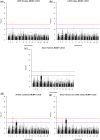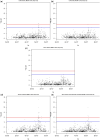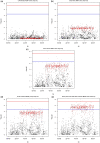Conserved QTL and chromosomal inversion affect resistance to columnaris disease in 2 rainbow trout (Oncorhyncus mykiss) populations
- PMID: 35666190
- PMCID: PMC9339330
- DOI: 10.1093/g3journal/jkac137
Conserved QTL and chromosomal inversion affect resistance to columnaris disease in 2 rainbow trout (Oncorhyncus mykiss) populations
Abstract
We present a comparative genetic analysis of the quantitative trait loci underlying resistance to warm water columnaris disease in 2 farmed rainbow trout (Oncorhynchus mykiss) populations. We provide evidence for the conservation of a major quantitative trait loci on Omy03, and the putative role played by a chromosomal rearrangement on Omy05. A total of 3,962 individuals from the 2 populations experienced a natural Flavobacterium columnare outbreak. Data for 25,823 genome-wide SNPs were generated for both cases (fatalities) and controls (survivors). FST and pairwise additive genetic relationships suggest that, despite being currently kept as separate broodstocks, the 2 populations are closely related. Association analyses identified a major quantitative trait loci on chromosome Omy03 and a second smaller quantitative trait loci on Omy05. Quantitative trait loci on Omy03 consistently explained 3-11% of genetic variation in both populations, whereas quantitative trait loci on Omy05 showed different degree of association across populations and sexes. The quantitative trait loci on Omy05 was found within a naturally occurring, 54.84 cM long inversion which is easy to tag due to a strong linkage disequilibrium between the 375 tagging SNPs. The ancestral haplotype on Omy05 was associated with decreased mortality. Genetic correlation between mortality in the 2 populations was estimated at 0.64, implying that the genetic basis of resistance is partly similar in the 2 populations. Our quantitative trait loci validation identifies markers that can be potentially used to complement breeding value evaluations to increase resistance against columnaris disease, and help to mitigate effects of climate change on aquaculture.
Keywords: GWAS; QTL; columnaris disease; inversion; rainbow trout.
© The Author(s) 2022. Published by Oxford University Press on behalf of Genetics Society of America.
Figures



References
-
- Aslam ML, Robledo D, Krasnov A, Moghadam HK, Hillestad B, Houston RD, Baranski M, Boison S, Robinson NA.. Quantitative trait loci and genes associated with salmonid alphavirus load in Atlantic salmon: implications for pancreas disease resistance and tolerance. Sci Rep. 2020;10(1):10393. doi:10.1038/s41598-020–67405-8. - PMC - PubMed
-
- Ayllon F, Kjærner-Semb E, Furmanek T, Wennevik V, Solberg MF, Dahle G, Taranger GL, Glover KA, Almén MS, Rubin CJ, et al.The vgll3 locus controls age at maturity in wild and domesticated Atlantic salmon (Salmo salar L.) males. PLoS Genet. 2015;11(11):e1005628. doi:10.1371/journal.pgen.1005628. - DOI - PMC - PubMed
MeSH terms
Associated data
LinkOut - more resources
Full Text Sources
Miscellaneous
